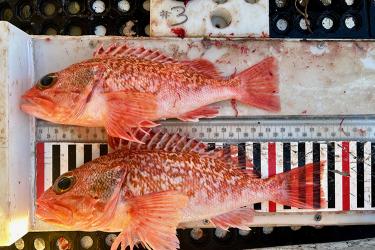I was onboard the F/V Dyrsten for a 3-day research trip last June to investigate how oceanography affects shortfin squid movement and biology in the Mid-Atlantic Bight. This work is just one component of our center’s cooperative effort with industry to better understand our squid stocks . By pairing oceanographic data with abundance and biomass estimates we hope to provide insight into squid biology and movement.
The data collected on this trip lay the groundwork for the next 2 years of this project. Our goal was to collect a suite of oceanographic and biological data including:
- Chlorophyll and oxygen isotope water samples using a Niskin bottle
- Conductivity (salinity), temperature, and depth, measured both with instruments deployed from a winch in the stern of the vessel and instruments attached to the headrope of the net
- Zooplankton samples collected in a ring net
- eDNA collected using a new technique
Collecting this amount of data on a fishing vessel was no small undertaking. I was just one member of an interdisciplinary crew made up of four fishermen and six biologists and oceanographers working together to understand this fast-growing and short-lived species.
On our first day, the Dyrsten steamed from Cape May, New Jersey, across the continental shelf toward the shelf break. The shelf break is oceanographically complex and is the preferred habitat for shortfin squid. Audy Peoples was our oceanography expert. Audy, having spent many days at sea on our Ecosystem Monitoring cruises , showed no hesitation as he prepared the CTD despite the fishing vessel being different from NOAA research ships. The goal of day one was to successfully deploy the oceanographic gear at three locations.
Our arrival at the first station set off a flurry of preparation. With Audy’s guidance, the Dyrsten crew—Steve Axelsson, Leif Axelsson, David Axelsson, and Matt Loughlin—deployed the gear like seasoned oceanographers. By station two, the five worked together like a well-oiled machine. The Dyrsten crew adjusted to their new roles as oceanographers with a swiftness and ease that comes naturally to those used to the unpredictable nature of the ocean. Day one concluded with the successful completion of three stations and we were eager to start fishing for squid the following day.
Day two began with a sunrise oceanography deployment followed by our first fishing effort of the trip. I watched the Dyrsten’s crew in action as they deployed the oceanographic gear and then immediately prepared the trawl net for the first station. While we anxiously waited for the trawl to return to the deck (filled with squid, we hoped!), we extracted water samples from the Niskin bottle, reviewed the data from the CTD, and preserved the plankton caught in the ring net for further analysis back at the lab.
We teemed with excitement as they hauled up the net. It held a clean catch of lively squid with a few silvery ribbonfish mixed in. With the help of the Dyrsten crew, we lined up at the conveyor belt and sorted the catch. The intensive biological sampling process didn’t stop there. We collected lengths and weights for the squid and packed up additional squid to freeze and dissect back at the lab. There, we would collect data on sex, maturity, and age, and collect DNA samples.
Over my 3 days aboard the Dyrsten , we characterized the oceanography at 14 locations in the Mid-Atlantic and caught approximately 25,000 pounds of shortfin squid. The data we collected will improve our understanding of how ocean conditions affect shortfin squid movement and biology. I am eager to get back out on the Dyrsten next year and see what the ocean and squid have in store for us.








